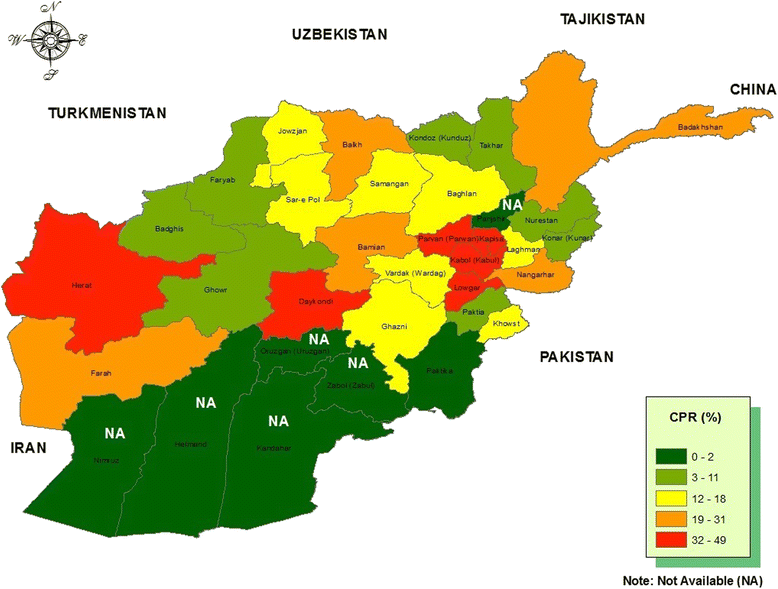Uptake and predictors of contraceptive use in Afghan women
- PMID: 25783646
- PMCID: PMC4336684
- DOI: 10.1186/s12905-015-0173-6
Uptake and predictors of contraceptive use in Afghan women
Abstract
Background: Afghanistan has one of the world's highest fertility rates and, related to this, an infant mortality rate far higher than its South Asian neighbors. Contraception enhances family spacing, improves women's safety in child birth and, as a result, reduces infant and child mortality. Until recently, there has been a paucity of information on the comparative rates of contraceptive practices in the country and socioeconomic correlates of uptake. We aimed to elucidate the factors influencing the use of contraception in Afghanistan using recent, robust national data.
Methods: Using Afghanistan Mortality Survey (AMS) 2010 data, the distribution of Contraceptive Prevalence Rate (CPR) and correlates of contraceptive use among currently married women aged 15-49 years were explored. We initially summarised descriptive data on 25,743 married women and then derived predictors of the use of any form of contraception using a multiple logistic regression model.
Results: The prevalence of self-reported current use of any contraceptive method was 21.8% (95% CI: 20.4-23.4) at the national level though there was a wide variation in practice between provinces. Herat province in the West region had a highest contraceptive prevalence rate of 49.4% while Paktika in the Southeast region had the lowest CPR of 2%. Multiple logistic regression analysis showed that a family size of greater than 6 living children strongly predicted contraceptive use (AOR 7.4 (95% CI:6.1-9.0)). Other independent predictors included: secondary or high level of education (AOR 2.1 (95% CI: 1.8-2.5)) and being in the wealthiest stratum (OR 2.1 (95% CI 1.5-3.0)). Rural residence predicted a lower use of contraception (AOR, 0.72; 95% CI: 0.56-0.92).
Conclusion: Contraceptive uptake rate was low overall with wide inter provincial variation. Strengthening female education, targeting married women in rural area and women with no education may enhance the effectiveness of National Family planning program in Afghanistan.
Figures
References
-
- Central Statistic Organization, population estimation, [http://cso.gov.af/en/page/demography-and-socile-statistics/demograph-sta...]
-
- Afghan Public Health Institute, Central Statistics Organization, ICF Macro, Indian Institute of Health Management Research & World Health Organization Regional Office for the Eastern Mediterranean, Afghanistan Mortality Survey 2010 [http://dhsprogram.com/publications/publication-fr248-other-final-reports...]
MeSH terms
Substances
Grants and funding
LinkOut - more resources
Full Text Sources
Other Literature Sources
Medical


